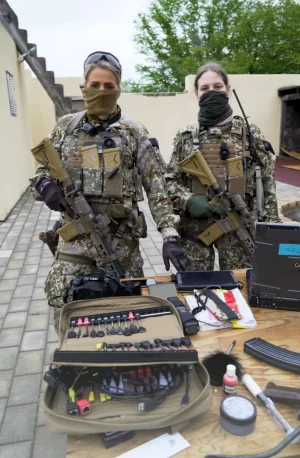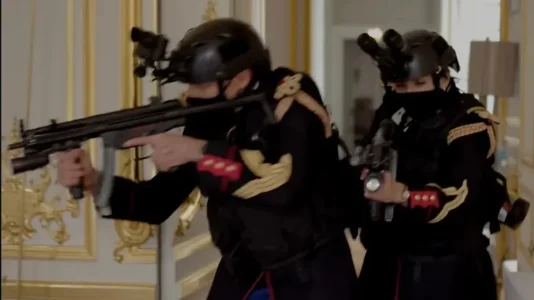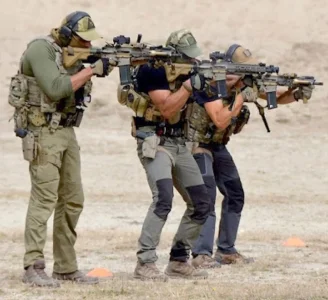- Joined
- Jun 30, 2024
- Messages
- 2,064
- Likes
- 7,175
No relaxed norms. Support companies have their own criteria. Then they are deputed/attached to combat units.Do females here join through deputation or through relaxed norms
TSO Offizier
 Here's a long ass overview of KSK and its support companies. Also shoutout to Herr Useful_Intention9754!
Here's a long ass overview of KSK and its support companies. Also shoutout to Herr Useful_Intention9754!The Kommandospezialkräfte (KSK) was founded in 1996 after the need for a unit was established which would be able to conduct offensive operations behind enemy lines. The specific incident which prompted the creation of the KSK was the evacuation of German citizens by Belgian commandos during the Rwandan Genocide of 1994 due to the German government deeming both KSM and GSG9 to be incapable of conducting the operation at the time due to their lacking experience of the subject matter. KSK ran its first combat operations in 1998, two years after its inception, the first of which being “Operation Kilo” which resulted in the capture of HVT Milorad Krnojelac. The operation went smoothly and was planned alongside members of French, Dutch, UK and US SOF elements, which are to-date some of KSKs closest partners.
The KSK is based primarily on 22SAS, GSG9, Sayeret Matkal and Delta Force with the first German unit operators being flown out to the aforementioned SOF outfits as to hone their skills: GSG9 primarily for sniping, capturing ships, buses and planes; SAS primarily for “Commando Combat”; Sayeret Matkal primarily for CT operations and US SOF primarily for long-range engagements, specifically with the M82.
The KSK has since established itself as premier NATO SOF outfit, working closely with domestic and international counterparts, maintaining close relationships with high-speed units during combat deployments, exercises and personnel exchange programs specifically: CAG, KCT, GROM, 22SAS, SEALs, US SFGs, JTF2, 2 Cdo Regt, ARW, Jagdkommando, Israeli SOF, French SOF, Mexican SOF, Tunisian SOF and many more. Now whilst it is known that KSK works with a variety of domestic and international Police/CT elements, I have recently stumbled upon footage of a Multitarn operator partaking in a ATLAS exercise which further increases the likelihood of military units partaking in said exercises. I can not however confirm the operator was KSK, could very well be KSM as the task at hand was VBSS.
KSK consists of three commando companies plus a plethora of supporting units/companies, after the second commando company was dissolved throughout the latter stages of the 2010s, operators of which being assigned to other companies whilst the KSK was the subject of heavy scrutiny due to severe controversy, which led to the unit being reformed in 2020. Nowadays the KSK operates with the full blessing of the German government and the Bundeswehr after having undergone a multitude of measures to further the “transparency” of the organization. The extent of which, at closer inspection is fairly surface-level, as is to be hoped and expected from a tier-one outfit.
Structure:
KSK Staff
- Psychological Service
- Language Service
Staff and Command Support Company
1st Commando Company
3rd Commando Company
4th Commando Company
Special Commando Company
Special Reconnaissance Company
Signal Company
Support Company
- Quartermaster/ Handling Platoon
- Maintenance Platoon
- Parachutes/ Air Handling Platoon
Medical Center
Training Department
Development Department
“Combat-ready” units are split up in to three commando companies each consisting of roughly 100 operators which are further split up into 5 specialized platoons.
- Command Platoons
- 1st Platoon: vehicle insertion (Land/Desert)
- 2nd Platoon: airborne insertion
- 3rd Platoon: amphibious operations
- 4th Platoon: Mountainous/Arctic operations
- 5h Platoon: reconnaissance, intelligence and sniper/counter-sniper operations
As of 2018 KSK has its own medical brigade the SanSpzZug which is integrated into the respective commando companies, as to provide further, extensive medical care during and after operations. Ultimately increasing the efficacy of MED/CASEVAC scenarios. There is far more detail as to the extent of KSKs structure, the core principle being: Every operator is specialized either as a: weapons specialist, medic, combat engineer or comms expert respectively. Additionally every commando is assigned/chooses their preferred specialization of Platoon. AFAIK every combat-ready KSK operator must be proficient in basically everything, which entails operators specialized in Amphibious operations also being versed in HAHO/HALO, Tacdrive, Mountainous/Arctic operations and reconnaissance ops. Another element of unconventional warfare which was first presented to me in a book written by former KSK operator “Markus Gaul” is that select KSK operators partake in clandestine/black ops with Germanys intelligence services. Outlining operations and training outside of the “conventional” scope of KSKs capabilities.
KSKs core order entails:
- Hostage rescue abroad
- Counterterrorism
- Commando warfare
- Combatting HVTs
- Capturing HVIs
- Training and developing international SOF elements
- Gaining key operational intelligence
KSK has and will continue to run operations internationally, the vast majority of which remain classified. Known deployments include:
- Bosnia and Herzegovina
- Afghanistan
- Iraq
- Libya
- Tunisia
- Niger
- Mali
- Jordan
- Westafrika
- Sudan
- Cyprus
- Lebanon
KSKs training-facilities nowadays are considered to be some of the most advanced worldwide, being stationed in Calw, Germany. A prime example being their primary shoothouse “Gebäude 8” as it is known to be a cutting-edge compound which has been used by units from well over 60 nations due to its unique capacities. A key benefit to “Gebäude 8” is that it has the capacity to recreate every German embassy on the globe in minutes, by being entirely modular via software, further increasing the efficacy of training by further bridging the gap between combat and training.
Outlining the entirety of their gear would go beyond the scope of this brief summary, in short KSK fields the most modern and appropriate systems available, their procurement processes being largely independent from the Bundeswehr as a whole thus drastically increasing the efficiency of procuring gear. KSK internally develops and advances pre-existing products by being a key player in the industry, testing new products to the highest-standard and developing their own derivatives of products such as the HK416A7 alongside CAG as part of the 416 program. As such KSK often acts as a testing station for products which are meant to be fielded by conventional forces, a prime example of which being the G36 back in the 90s or the 416 nowadays. This is further exemplified by the KSK symposium, which is an annual get-together of gear and defense manufacturers that aim to show off their latest and greatest shit in the Graf Zeppelin Barracks.
Their motto is “facit omnia voluntas” which translates to “the will is decisive”.
The KSK is based primarily on 22SAS, GSG9, Sayeret Matkal and Delta Force with the first German unit operators being flown out to the aforementioned SOF outfits as to hone their skills: GSG9 primarily for sniping, capturing ships, buses and planes; SAS primarily for “Commando Combat”; Sayeret Matkal primarily for CT operations and US SOF primarily for long-range engagements, specifically with the M82.
The KSK has since established itself as premier NATO SOF outfit, working closely with domestic and international counterparts, maintaining close relationships with high-speed units during combat deployments, exercises and personnel exchange programs specifically: CAG, KCT, GROM, 22SAS, SEALs, US SFGs, JTF2, 2 Cdo Regt, ARW, Jagdkommando, Israeli SOF, French SOF, Mexican SOF, Tunisian SOF and many more. Now whilst it is known that KSK works with a variety of domestic and international Police/CT elements, I have recently stumbled upon footage of a Multitarn operator partaking in a ATLAS exercise which further increases the likelihood of military units partaking in said exercises. I can not however confirm the operator was KSK, could very well be KSM as the task at hand was VBSS.
KSK consists of three commando companies plus a plethora of supporting units/companies, after the second commando company was dissolved throughout the latter stages of the 2010s, operators of which being assigned to other companies whilst the KSK was the subject of heavy scrutiny due to severe controversy, which led to the unit being reformed in 2020. Nowadays the KSK operates with the full blessing of the German government and the Bundeswehr after having undergone a multitude of measures to further the “transparency” of the organization. The extent of which, at closer inspection is fairly surface-level, as is to be hoped and expected from a tier-one outfit.
Structure:
KSK Staff
- Psychological Service
- Language Service
Staff and Command Support Company
1st Commando Company
3rd Commando Company
4th Commando Company
Special Commando Company
Special Reconnaissance Company
Signal Company
Support Company
- Quartermaster/ Handling Platoon
- Maintenance Platoon
- Parachutes/ Air Handling Platoon
Medical Center
Training Department
Development Department
“Combat-ready” units are split up in to three commando companies each consisting of roughly 100 operators which are further split up into 5 specialized platoons.
- Command Platoons
- 1st Platoon: vehicle insertion (Land/Desert)
- 2nd Platoon: airborne insertion
- 3rd Platoon: amphibious operations
- 4th Platoon: Mountainous/Arctic operations
- 5h Platoon: reconnaissance, intelligence and sniper/counter-sniper operations
As of 2018 KSK has its own medical brigade the SanSpzZug which is integrated into the respective commando companies, as to provide further, extensive medical care during and after operations. Ultimately increasing the efficacy of MED/CASEVAC scenarios. There is far more detail as to the extent of KSKs structure, the core principle being: Every operator is specialized either as a: weapons specialist, medic, combat engineer or comms expert respectively. Additionally every commando is assigned/chooses their preferred specialization of Platoon. AFAIK every combat-ready KSK operator must be proficient in basically everything, which entails operators specialized in Amphibious operations also being versed in HAHO/HALO, Tacdrive, Mountainous/Arctic operations and reconnaissance ops. Another element of unconventional warfare which was first presented to me in a book written by former KSK operator “Markus Gaul” is that select KSK operators partake in clandestine/black ops with Germanys intelligence services. Outlining operations and training outside of the “conventional” scope of KSKs capabilities.
KSKs core order entails:
- Hostage rescue abroad
- Counterterrorism
- Commando warfare
- Combatting HVTs
- Capturing HVIs
- Training and developing international SOF elements
- Gaining key operational intelligence
KSK has and will continue to run operations internationally, the vast majority of which remain classified. Known deployments include:
- Bosnia and Herzegovina
- Afghanistan
- Iraq
- Libya
- Tunisia
- Niger
- Mali
- Jordan
- Westafrika
- Sudan
- Cyprus
- Lebanon
KSKs training-facilities nowadays are considered to be some of the most advanced worldwide, being stationed in Calw, Germany. A prime example being their primary shoothouse “Gebäude 8” as it is known to be a cutting-edge compound which has been used by units from well over 60 nations due to its unique capacities. A key benefit to “Gebäude 8” is that it has the capacity to recreate every German embassy on the globe in minutes, by being entirely modular via software, further increasing the efficacy of training by further bridging the gap between combat and training.
Outlining the entirety of their gear would go beyond the scope of this brief summary, in short KSK fields the most modern and appropriate systems available, their procurement processes being largely independent from the Bundeswehr as a whole thus drastically increasing the efficiency of procuring gear. KSK internally develops and advances pre-existing products by being a key player in the industry, testing new products to the highest-standard and developing their own derivatives of products such as the HK416A7 alongside CAG as part of the 416 program. As such KSK often acts as a testing station for products which are meant to be fielded by conventional forces, a prime example of which being the G36 back in the 90s or the 416 nowadays. This is further exemplified by the KSK symposium, which is an annual get-together of gear and defense manufacturers that aim to show off their latest and greatest shit in the Graf Zeppelin Barracks.
Their motto is “facit omnia voluntas” which translates to “the will is decisive”.

















